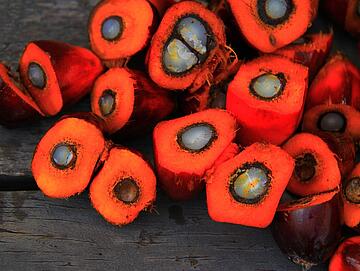
Detection of Chlorine in Palm Oil
Tue 27 Apr, 2021
Margarine, spreads, chocolate, detergents, cosmetics, biofuels and much, much more - palm oil simply everywhere and in almost everything nowadays. Hardly any other natural product is used as widely for industrial production as this tropical oil. Palm oil - or palm fat as it is also called - is relatively inexpensive to produce. The yield per area is exceptionally high compared to similar oil suppliers such as rapeseed. But more importantly, palm oil has many special properties that are beneficial for a variety of industrial products. In the food industry, the oil's heat resistance is used, in particular, to produce baking and frying fats, among other things. Manufacturers of detergents use palm oil to produce surfactants that serve as solubilizers in detergents. The energy sector sees palm oil as a favourable starting product for biofuels, due to the good yield and energy density of the oil.
Risks of Palm Oil
There are two problems associated with the popularity of palm oil: On the one hand, there is the clearing of the rainforest and the emergence of monocultures to meet the increasing demand - with all the ecological and also socio-economic consequences for the affected regions. Secondly, palm oil has to be refined in order to be processed. This often results in impurities that impair the quality and thus can affect the health security of the respective end products - if they are used for food. We would like to deal with the second point in more detail here. Strictly speaking, we are dealing with one of the most common impurities in the refining process: chlorine compounds such as chlorpropanediols, which are harmful to the environment and health.
How do chlorpropanediols get into palm oil?
Palm oil must be refined to improve its taste properties and shelf life. However, palm oil treated in this way can pose a health risk to consumers. Various studies in recent years have demonstrated the presence of 3-monochloropropane-1,2-diol (3-MCPD) fatty acid esters in refined palm oil. 3-MCPD is formed when fats and oils are exposed to high temperatures, in the presence of organic and inorganic bound chlorine, often during the refining process. 3-MCPD is suspected to increase the risk of cancer. Animal studies have shown that higher intake of 3-MCPD leads to kidney and liver damage and benign tumours. The World Health Organization has therefore set a limit for an acceptable daily intake of two micrograms of 3-MCPD per kilogram of body weight.
How does the optimal detection of chlorine and chlorine compounds in palm oil work?
Palm oil is used as a food ingredient and is therefore subject to strict quality and food safety controls. In addition to the determination of antioxidants, water content or trace elements (Pb, As, Cd and Hg), the determination of total chlorine plays an important role. The organic elemental analysis is ideal for this purpose. It is based on oxidative combustion with micro-coulometric detection. Analytik Jena consistently pursues this technological approach in all of its elemental analyzers, since the quality of results and their general reliability are thus decisively improved.
To demonstrate the method, we analyzed two different palm oil samples: Red palm oil, a viscous oil used as a high-quality, cold-pressed frying oil, and 100 percent natural palm oil. A multi EA 5000 did the analysis work. The multi EA 5000 is an elemental analyzer that can detect not only chlorine but also nitrogen, carbon and sulfur in a wide variety of starting materials - solid, liquid or gaseous.
The two different palm oil samples were analyzed twice - once directly in solid mode and a second time in liquid form. For dilution o-xylene was used. The results and measurements of two selected Cl standard solutions are summarized in the tables and diagrams. The results are average values from three repeat measurements.
The different approaches to sample pretreatment give comparable results with deviations of less than 5 %. Both types of pretreatment are suitable for analysis, even of different palm oil samples. Nevertheless, the dilution of the samples leads to a smaller deviation of the analysis results. This fact, combined with the easier handling of the samples and faster analysis time, makes the dilution variant a more optimal sample preparation strategy.
Detailed information on the detection of total chlorine in palm oil can be found in our corresponding AppNote.

Comments (0)
No comments found!